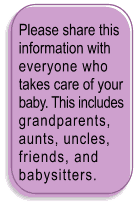 |
|
Sudden Infant Death Syndrome (SIDS): Safe Sleep Environment |
|
How can you help your infant sleep and nap safely?

- Infants should ALWAYS be placed
on their backs (face up) when they are resting, sleeping, or left alone.
- Infants should be placed on
their tummies (tummy time) ONLY when they are awake and supervised by
someone responsible. Supervised tummy time is encouraged to help make your
infant’s neck and back muscles strong.
- When infants are napping or
sleeping they should ONLY be placed in cribs approved by the Consumer
Product Safety Commission (CPSC).
- Mattresses should ALWAYS fit
snugly into the crib’s frame.
- Cribs made after 1982 and
sold in the United States by a retailer should, by law, meet the CPSC
safety standards for cribs.
- If you do not have a crib, your
infant can be placed to sleep on another safe, firm sleep surface such as
a bassinet, cradle, or co-sleeper that does not have any soft or fluffy
items on its sleep surface
- Infants should ALWAYS be placed
on a firm surface or mattress.
- Dress your infant in a sleeper
or warm pajama instead of covering infant with a blanket.
- If you choose to cover your
infant, ALWAYS make sure the blanket stays at or lower than the infant’s
waist.
- ALWAYS dress your infant the
way that you would want to be dressed for the temperature around you.
- Parents or caregivers who
choose to share a bed with their infant should NEVER smoke or be under the
influence of alcohol or drugs while sleeping with their infant.
- Parents or caregivers who want
to be close to their infant while they are sleeping can move the crib,
bassinet, or co-sleeper next to their bed.
- Safest place for an infant to sleep is in their own crib or other
separate safe sleep surface next to the parent or caregiver's bed.
- NEVER place your infant on a
sofa, couch, pillow, or waterbed.
- NEVER place your infant to
sleep or to nap with any pillows, stuffed toys, bumper pads, comforters,
quilts, or sheepskin.
- NEVER smoke in the same room as
an infant or child.
- NEVER let anybody else smoke in
the same room as your infant or child.
References for Safe Sleeping Environments
The changing concept of sudden infant death syndrome: diagnostic coding
shifts, controversies regarding the sleeping environment, and new variables
to consider in reducing risk. American Academy of Pediatrics. Task Force on
Sudden Infant Death Syndrome. Pediatrics 2005;116:1245–1255.
Hauck FR, Herman SM, Donovan M, Iyasu S, Merrick MC, Donoghue E et al.
Sleep environment and the risk of sudden infant death syndrome in an urban
population: the Chicago Infant Mortality Study. Pediatrics
2003;111:1207–1214.
Moon RY, Patel KM, Shaefer SJ. Sudden infant death syndrome in child care
settings. Pediatrics 2000;106:295–300.
|
* |
Links to non-Federal organizations found at this site are provided solely as a service to our users. These links do not constitute an endorsement of these organizations or their programs by CDC or the Federal Government, and none should be inferred. The CDC is not responsible for the content of the individual organization Web pages found at these links.
|
Page last reviewed:
3/15/08
Page last modified: 3/15/08
Content source: Division
of Reproductive Health,
National Center for Chronic
Disease Prevention and Health Promotion |
 |
|